2012 Taipei Arts Awards
By Gobby Wang The Grand Prize in the awards went to Chou Yu-cheng, with Honorable Mentions going to Chu Chun-Teng, Chuang Jung-che, Chen Yun, Huang Yen-Chiao and Liu Yu/Wu Sih-chin. In addition, seven others won Selected Awards, including Lee Hsin-che, Chuang Che-wei, Hsu Yi-tzu, Yang Tzu-hung, Tsai Shih-hung, Tai Han-hong and Lou Jr-shin. The awards ceremony took place on December 23 on the occasion of the 29th anniversary of Taipei Fine Arts Museum. Liou Wei-kung, Director of the Bureau of Cultural Affairs of the Taipei Municipal Government, awarded the Grand Prize and other awards to each winner. Chou Yu-cheng, the Grand Prize winner, received a trophy, a Certificate of Merit and a NT$550,000 cash prize. The five Honorable Mention winners were awarded a Certificate of Merit and a NT$120,000 cash prize for each other. Each Selected Award winner received a Certificate of Merit. In addition, Chou's will have the opportunity to display his work as part of a personal exhibition in TFAM in the near future. This is the 12th year of the Taipei Arts Awards, and the 2012 panel of judges consisted of the chairman Lin Hung-chang together with Wu Ma-li, Chuang Pu, Hsu Wen-jui, Kuo Ying-sheng, Mei Ting-yen and Chang Fang-wei, all experts from different artistic fields. Compared with the shortlist last year, the average age of nominees this year is about at 30 years old and the amount of video works submitted declined while the number of graphic-works increased. The majority of entries broke through the limits of materials, used a variety of formats to present their themes, resulting in a rich and varied exhibition. Chou Yu-cheng is the Grand Prize winner in the 2012 Taipei Arts Awards. His winning work is "A Working History - Lu Chieh-te", which uses deck, memoir, advertisement as parts of the installation. Chou asked Lu Chieh-te, who is a temporary and a writer to agree to a series of three interviews. He organized the result of the interviews into a narrative of Lu's whole life and made them into a book. In addition, he hired Lu to work at the Taipei Fine Art Museum for three months and created a visual anchored to the blue checked shirt that Lu wears all the time. The exhibition is marked by a blue checked stage, classified advertisements from newspapers, and images of Lu Chieh-te. The judges considered the fact that Chou was addressing the grey area between an artist and his works, at the same time inspecting the relationship between esthetics and society. Moreover, he reveals his political viewpoints in his work. Honorable mention Chu Chun-teng won an Honorable Mention for the second time with his 2012 entry "my name is little black." A myna bird learns how to speak in 26 languages of nations which have been affected by political transformation such as Japanese, Mandarin, Taiwanese, English and other native tongues. Chu also trained the little black bird to say "My name is little black," to represent Taiwan's history, a history which has gone through many changes. He intended to provide a way for people to rethink and look inward for themselves. The judges felt that he did well in showing a political fable for Taiwan with a scientific investment that was embedded with imitations. Chuang Jung-che's "Word-carved writings" presents penmanship and personal life experiences related to ethics. He utilizes photos of penmanship to record scars which have faded away as time goes on. He hopes that the observer will be able to face the scars squarely rather than running from the physiological and mental pain until it finally fades away as time goes by. Liu Yu and Wu Shi-chin work as a group. Their topic was "Two ends," a work which is aimed as a breakthrough point for social and religious issues, explaining the similarities and dissimilarities between society and art. They use images, models and installations to present two doomsday predictions that were spread in Taiwan in 1997 and 2011 and they also comment on issues reported in the media and shared, received and understood by people. Huang Yen-chiao's "Telecommunication, passive being" is a painting which shows that he understands human beings. It is displayed with a bright light and video that allow observers to experience a sense of speed. The judges said Huang's work combines video, installation art and graphic space to show how differences in nerves and circuitry make up the unique body of a person. Selected Awards Tai Han-hong presents his work "Passing in Between" with doors, wood, steel and machinery, letting observers feel how to break the limit of thoughts through visual images and real touching and action. Tsai Shih-hung's "Donut Cloud and Black Submarinez" is presented in QR code, requiring observers to upgrade the 2D anime to 3D. Hsu Yi-tzu's "Family Memory" uses negatives and handwriting to re-create her memories. Chuang Che-wei was inspired by "La jetée", directed by Chris Marker in 1962, and his work is also called "La jetée." He extends the plot of the movie to present the blurred image of a woman in the collective appearance of the paintings. Lee Hsin-che's "Shrouded in Clouds. Taipei" is an ultra Giclèe art print on fine art semi-glossy photo paper. It shows scenes in Taipei city that people are familiar with but ignore out of habit. Another winner of the Selected Award was Yang Tzu-hung's "Daily Hazard."
Staff Writer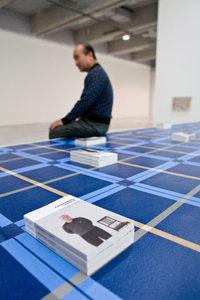 Taipei Fine Arts Museum officially announced the winners of the 2012 Taipei Arts Awards on December 20. A total of 13 works were selected in the awards including paintings, photography, videos, mixed media and conceptual behavior, showing the wide diversity of topics and media in the entries. Moreover, all works will be on display on B1 in the Taipei Fine Arts Museum from December 22 to March 10, 2013.
Taipei Fine Arts Museum officially announced the winners of the 2012 Taipei Arts Awards on December 20. A total of 13 works were selected in the awards including paintings, photography, videos, mixed media and conceptual behavior, showing the wide diversity of topics and media in the entries. Moreover, all works will be on display on B1 in the Taipei Fine Arts Museum from December 22 to March 10, 2013. 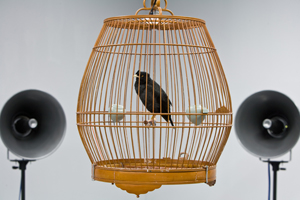 The 2012 Taipei Arts Awards began accepting entries which in 2011 and was open to a wide range of artists. The contest took place in several stages including a first evaluation, a review judging and a run-off judging. A total of 230 works were evaluated in the first stage, with 20 works going on to the review judging. In addition, the artists were asked to make a presentation regarding the themes of their works during the review phase, narrating the concepts behind their works and how they planned to present their works in the exhibition. The judges also asked them a number of questions to clarify the essence of the themes in each work to breaking through the limitations represented by reviewing printed materials. After the tense review process was finished, 13 outstanding works were selected for the shortlist and the run-off phase of judging. The nominees were then asked to implement their themes for the exhibition and the jury evaluated how they prepared for the exhibition.
The 2012 Taipei Arts Awards began accepting entries which in 2011 and was open to a wide range of artists. The contest took place in several stages including a first evaluation, a review judging and a run-off judging. A total of 230 works were evaluated in the first stage, with 20 works going on to the review judging. In addition, the artists were asked to make a presentation regarding the themes of their works during the review phase, narrating the concepts behind their works and how they planned to present their works in the exhibition. The judges also asked them a number of questions to clarify the essence of the themes in each work to breaking through the limitations represented by reviewing printed materials. After the tense review process was finished, 13 outstanding works were selected for the shortlist and the run-off phase of judging. The nominees were then asked to implement their themes for the exhibition and the jury evaluated how they prepared for the exhibition. 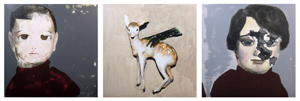 Chou Yu-cheng, winner of the Grand Prize
Chou Yu-cheng, winner of the Grand Prize
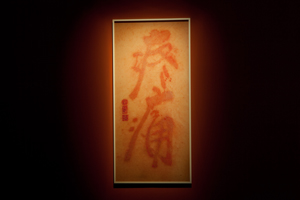 Chen Yun, one of the honorable mention winners, adopted different painting materials such as acrylic and canvas and dark colors for her work "I'll go to that place you said." The judges appraised Chen's work as skilled in using the paint and space to make the installed language like a real person speaking in front of you, mixing personal and group memories.
Chen Yun, one of the honorable mention winners, adopted different painting materials such as acrylic and canvas and dark colors for her work "I'll go to that place you said." The judges appraised Chen's work as skilled in using the paint and space to make the installed language like a real person speaking in front of you, mixing personal and group memories.
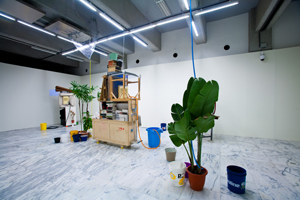 Luo Jr-shin was one winner of the Finalist Award. His work is "Water city – TFAM", which plays up the ideas that the climate in Taiwan is humid and damp. Many buildings have problems with leaks. His exhibition is full of dehumidifiers, plants, TVs and multi-channel videos with no sound. Luo hopes that people will realize that shared risks like the leaking problem really do exist in Taiwan.
Luo Jr-shin was one winner of the Finalist Award. His work is "Water city – TFAM", which plays up the ideas that the climate in Taiwan is humid and damp. Many buildings have problems with leaks. His exhibition is full of dehumidifiers, plants, TVs and multi-channel videos with no sound. Luo hopes that people will realize that shared risks like the leaking problem really do exist in Taiwan.

![Taiwan.gov.tw [ open a new window]](/images/egov.png)
